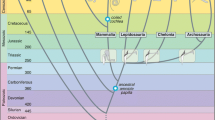Abstract
Like elephants, baleen whales produce low-frequency (LF) and even infrasonic (IF) signals, suggesting they may be particularly susceptible to underwater anthropogenic sound impacts. Analyses of computerized tomography scans and histologies of the ears in five baleen whale and two elephant species revealed that LF thresholds correlate with basilar membrane thickness/width and cochlear radii ratios. These factors are consistent with high-mass, low-stiffness membranes and broad spiral curvatures, suggesting that Mysticeti and Proboscidea evolved common inner ear adaptations over similar time scales for processing IF/LF sounds despite operating in different media.
Access this chapter
Tax calculation will be finalised at checkout
Purchases are for personal use only
Similar content being viewed by others
References
Cai H, Manoussaki D, Chadwick RS (2005) Effects of coiling on the micromechanics of the mammalian cochlea. J R Soc Interface 2:341–348
Echteler SM, Fay RR, Popper AN (1994) Structure of the mammalian cochlea. In: Fay RR, Popper AN (eds) Comparative hearing: mammals. Springer, New York, pp 134–171
Greenwood DD (1990) A cochlear frequency-position function of several species—29 years later. J Acoust Soc Am 87:2592–2605
Ketten DR (2000) Cetacean e ars. In: Au W, Fay RR, Popper AN (eds) Hearing by whales and dolphins. Springer, New York, pp. 43–108
Ketten DR, Skinner M, Wang G, Vannier M, Gates GA, Neely G (1998) In vivo measures of cochlear length and insertion depths of nucleus cochlear implant electrode arrays. Ann Otol Rhinol Laryngol 107:1–16
Ketten DR, Wartzok D (1990) Three-dimensional reconstructions of the dolphin cochlea. In: Thomas JA, Kastelein RA (eds) Sensory abilities of cetaceans: laboratory and field evidence. Plenum Press, New York, pp. 81–105
Langbauer WR, Payne K, Charif R, Rappaport E, Osborn F (1991) African elephants respond to distant playbacks of low-frequency conspecific calls. J Exp Biol 157:35–46
Manoussaki D, Chadwick RS, Ketten DR, Arruda J, Dimitriadis EK, O’Malley JT (2008) The influence of cochlear shape on low-frequency hearing. Proc Natl Acad Sci USA 105: 6162–6166
Manoussaki D, Dimitriadis EK, Chadwick RS (2006) Cochleas graded curvature effect on low frequency waves. Phys Rev Lett 96:088701
Marino L, Sol D, Toren K, Lefebvre L (2006) Does diving limit brain size in cetaceans? Mar Mamm Sci 22:413–425
Miller BS, Zosuls AL, Ketten DR, Mountain DA (2005) Middle ear stiffness of the bottlenose dolphin (Tursiops truncatus). IEEE J Ocean Eng 31:87–94
Payne K, Langbauer WR, Thomas E (1986) Infrasonic calls of the Asian elephant (Elephas maximus). Behav Ecol Sociobiol 18:297–301
Ridgway SH, Wood FH (1988) Dolphin brain evolution. Behav Brain Sci 11:99–100
Steele CR, Zais JG (1985) Effect of coiling in a cochlear model. J Acoust Soc Am 77:1849–1852
Wartzok D, Ketten DR (1999) Marine mammal sensory systems. In: Reynolds JE, Rommel SE (eds) Biology of marine mammals. Smithsonian Institution Press, Washington, DC
West CD (1985) The relationship of the spiral turns of the cochlea and the length of the basilar membrane to the range of audible frequencies in ground dwelling mammals. J Acoust Soc Am 77:1091–1101
Acknowledgments
This work was supported by the Office of Naval Research, the National Institutes of Health (NIH), the International Association of Oil and Gas Producers (OGP) Joint Industry Programme, and the National Institute of Deafness and Communication Disorders (NIDCD), NIH. We are grateful to Jennifer O’Malley, Barbara Burgess, and Diane DeLeo Jones for assistance with the histology and to Clarinda Northrup, the Cape Cod Stranding Network, and the International Fund for Animal Welfare (IFAW) for providing specimens. Above all, we acknowledge the mentorship and inspiration of our colleague Hezy Shoshani, who was a giant among his beloved leviathans and colleagues. He died in defense of his life’s work and is sorely missed.
Author information
Authors and Affiliations
Corresponding author
Editor information
Editors and Affiliations
Rights and permissions
Copyright information
© 2016 Springer Science+Business Media New York
About this paper
Cite this paper
Ketten, D.R., Arruda, J., Cramer, S., Yamato, M. (2016). Great Ears: Low-Frequency Sensitivity Correlates in Land and Marine Leviathans. In: Popper, A., Hawkins, A. (eds) The Effects of Noise on Aquatic Life II. Advances in Experimental Medicine and Biology, vol 875. Springer, New York, NY. https://doi.org/10.1007/978-1-4939-2981-8_64
Download citation
DOI: https://doi.org/10.1007/978-1-4939-2981-8_64
Publisher Name: Springer, New York, NY
Print ISBN: 978-1-4939-2980-1
Online ISBN: 978-1-4939-2981-8
eBook Packages: Biomedical and Life SciencesBiomedical and Life Sciences (R0)



